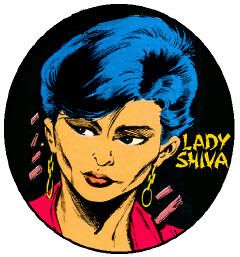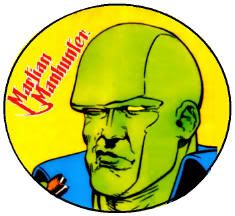Greetings gills and ghouls, it's that time again for the hostess with the mostest, in Elvira's House of Mystery #6. Under another great Mark Beachum cover with a fairly solid likeness that enthusiastically incorporates Elvira's plunging neckline is a slightly frustrating conceit. This issue is meant to be read sideways, spine up. On the plus side, that means nearly twice as much story this issue. On the down side, each page features two standard story pages, squished to fit with a big gap in the middle, and it's pretty good art done this disservice.
Tom Grindberg and Jim Fern mind Elvira's assets in the introduction that segues into the yarn "A New York Yankee in King Arthur's Court!" with the Bierbaums. It's clear Tom and Mary are fans, and produced this one specifically for this magazine, because Elvira continues to break in throughout the tale to narrate and quip. Grindberg is very much in Neal Adams mode as a baseball player wrestles with Medieval Times, and Elvira's dress wrestles with her curvy figure.
Next is "Subject for Post-Mortem" by Robert Kanigher and George Freeman, where a grave robbing physician ends up on the wrong end of the scalpel. "Two-Edged Sword" by Elizabeth M. Smith, Charles Nicholas, and Joe Giella comes across a bit hoary, especially when the last panel offers an Elvira that looks more like the Mark Beachum interstitial pages, and could easily have once been a Cain corner instead. Heck, there's even a painting of Cain on the next panel following, as if nodding to a paste-in.
The conquistadors of Kanigher & Jess Jodloman "You'll Beg to Die!" meet a grisly fate in another Adams-indebted piece, though this one with additional Filipino flair. Again, the pasted-in Beachum Elvira in the last panel gives up the game of this being a converted inventory story from some previously canceled horror anthology. There's no room for that contrivance in Joey Cavalieri & Ric Estrada's "Just Like Clockwork," which looks like it was drawn in the same time as the Kubrick flick they're referencing. The style and fashions would have been outdated a decade earlier, so I have to assume Cavalieri just scripted pages that had never made it to the lettering stage.
But just so you don't forget who's running this show, Beachum comes back for one more va-va-va-voom pin-up. Hopefully someday any rights issues can be untangled to reprint his pages in proper scale, hopefully while Elvira's still around to sign it. Oh, and her fan club springs for an ad, offering an autographed 8x10, bumper sticker and more for just $6.50 plus postage. The high contrast Xeroxed photos only add to the resemblance in the Grindberg & Beachum pages. The next issue had four pages of new interstitials to make up for the rest obviously being repurposed inventory from one of the axed science fiction anthologies, and even with a Bill Sienkiewicz cover, I couldn't see my way to supporting that one.
My half-brother splurged on the double-sized $1.25 G.I. Joe a Real American Hero #50. The Rod Whigham-drawn lead story was "The Battle of Springfield," bringing to a head a long simmering subplot about an entire suburb having been taken over by Cobra infiltrators. This one was packed with memorable moments, like the spies burning documents in the fireplace as tanks roll down main street, or a dad preparing to shoot the family dog in front of his kids before evacuating. Serpentor was still cool at this point, topless in jeans adorned only by the king cobra cowl and a cape. He lustily plunges into the fray, and when shot, cauterizes the wound with a heated knife. Storm Shadow is resurrected in a chemical vat, and is none to happy about it. Then there's a preview story for the upcoming spin-off G.I. Joe Special Missions, with returning original artist Herb Trimpe. He was previously assimilated by Bob McLeod, but here he inks himself, taking a cue from Tony Salmons and Kyle Baker with a loose, sketchier, more contemporary style. This one has a lot of grit, with the Joes facing airplane hijackers, without shying away from the violence of such a terroristic act. I think this was the first story I ever encountered to feature tasers. Good stuff!
To my mind, a cover with a mass of heroes carrying the massive form of an unconscious Hulk is a lot more memorable than another brawl, but as it happens, The Incredible Hulk #322 is mostly an exceptionally brutal slugfest. It fulfills the promise of recent, lackluster issues, even if I'll never get used to Dell Barras embellishing Al Milgrom.
I don't think Marvel Age was ever on the newsstand, but my half-brother had access to a comic shop, and would sometimes pick it up for a pair of quarters. #41 offered a fumetti cover of Stan Lee, but was otherwise a lackluster issue. I did get use out of "The Marvel Age," a serialized text feature on Marvel Comics history that filled in the gap between Marvel Saga and my '80s purchases, this month covering 1972 in first installment.
The Marvel Saga, the Official History of the Marvel Universe #9 downgrades the new Angel origin story pages from Sienkiewicz to Steve Geiger, which is not helpful. The Keith Pollard cover offering the initial Spider-Man/Doctor Octopus battle doesn't much salve that wound. There's also a lot of Vulture, Kree, and Red Ghost material here. The book is moving closer to a capsule index over the more narrative synopses of previous issues, so Puppet Master and Radioactive Man only rate a panel each. The Wasp gets a few pages, but it's hard not to notice the disproportionate space afforded Spider-Man stories involving losers like the Tinkerer. Sometimes it feels like the book wants to be Marvel Tales instead of Marvel Saga.
And now, a brief review of my history with Keith Giffen to date: I had one of the Flash issue with a Giffen Dr. Fate back-up, from when he still drew a little like George Perez. Ditto his two page advertainment piece from the first 1983 DC Sampler. I was also drawn to house ads for The Omega Men and the Baxter format Legion relaunch, though between the two, Giffen's style had changed so much as to be nigh unrecognizable from one to the other. Sometime around 1983, Giffen was exposed to the Argentine artist Jose Munoz, known for a loose, high contrast style somewhat like what Steranko had used on Chandler and Miller would use on Sin City. This exposure effectively broke and rebuilt Giffen, who locked himself in a room for days, just studying every panel of Munoz. Afterwords, his approach to art was forever change, to the point where outlets like The Comics Journal accused Giffen on plagiarism, but he always swore that he never had a Munoz page on his table when he was drawing. You know how Brad Pitt used to adopt the fashion style of every woman that he was in a relationship with? Giffen was like that with artists, beginning with Jack Kirby, and going through periods of heavy Kevin Maguire and Simon Bisley influence after having worked with them. Munoz though, was never a commercial success in the west, and between the critics calling his a swiper and the fanboys detesting how the Munoz look applied to super-heroes, Giffen committed career suicide. He went from a fan favorite to a pariah almost overnight. The one project that he was able to hold on to and experience some modest success with was his humor character, Ambush Bug, featured in a string of Superman comics and a solo mini-series.
I missed all that stuff. I came on with the second issue of the follow-up mini-series, Son of Ambush Bug. Now, I believe my interest was piqued by the first issue's cover, in which Ambush Bug is essentially buried in sensationalistic cover blurbs. Yet, I did not pick it up. Rereading it today, it might have been the extended manga parody starring the Japanese Ambush Bug battling a kaiju. Maybe I just wanted something else more and missed my shot. But I did buy the second issue, with an almost entirely red cover depicting Ambush Bug at the gates of literal Hell. Let me tell you-- I went back and bought the first mini-series in 1987, and most of the other stuff in 1989. The Ambush Bug Stocking Stuffer was one of many swell holiday parodies by the Jewish creator. The pre-1986 Bug material remains some of the most hilarious western super-hero material ever created. But Son of Ambush is not funny. In retrospect, it's about the depression, regret, and paranoia surrounding what Giffen probably felt was his second and final self-sabotaging of his artistic career, assuming he'd end up back selling vacuums or working at a chemical plant. Whether another example of slitting his wrists, or, more likely, an editorial mandate from a "New DC" wanting to be taken with the utmost seriousness in the Post-Crisis landscape, the mini-series was denied access to, basically, the entire DC Universe. There are references to name villains represented as in-story hand puppets, with Swamp Thing portrayed by a potted house plant, and Superman's discarded boot makes appearances. Otherwise, a book that by design was an anarchic take on DC properties had to create everything from whole cloth, at a time when Giffen was at a creative nadir, and he had no other choice but to carry on with his only viable project. Looking at it today, this book is bizarre, extremely dark, repetitive, derivative, and needlessly cruel.
I was utterly fascinated with it. I'd been around comics for my entire life, actively collecting for several years, and I'd never seen anything like it. The grotesquely realistic citizens populating a filthy, grimy, sticky urban hellscape. Contrasted against a lanky lime green loser trapped in a bug suit, whining about his life and devoted to a Cabbage Patch Doll dressed as his sidekick. Except it's a comic book, so I can't tell that Cheeks the Toy Wonder isn't a small, mute, blankly straing and largely inanimate child. You've got all these ugly weirdos talking to-- who? I can't tell. Their feet? The balloons are coming from their feet? And what are they talking about? A plot to murder Ambush Bug, who is already so lost and worthless, why go through the trouble? But they do, not once, or twice, but five times, at some length, and once as a mirror image of the first time, but with gobbledygook dialogue. And when Bug does go to the infernal, it's a Gilliamesque bureaucratic nightmare, and he's led there by his guardian angel, who's a haggard old abusive drunk who openly hates his charge. And the Cabbage Patch Doll is in his own short war story that was probably my first comic with homosexual subtext. But also, it's full of intense close-ups, near abstract images largely divorced from the context of the narrative. And though there are a number of splash pages, most story pages have a minimum of nine panels, with many closer to 12-13. Hey, here's eight random panels of ways to die in outer space. Here's a couple of moronic secret agents, one speaking in a Father Guido Sarducci Italian accent, looking at scraps of a costume under a microscope for over 19 panels across two pages. Here's a multi-page sequence about talking, animated socks. It was so obtuse, so creepy and gross and undecipherable. It was my first exposure to David Lynch, except it was Keith Giffen, and I needed more.
Superman #422 had a glorious monochrome Brian Bolland cover of Kal-El transforming into some sort of were-thing, with only his blood red eyes colored. Too bad the interiors were by Curt Swan, who even buried under heavy, dark inks took the lead right out of the pencil. This one haunted the Marauder Books quarter bin, thwarted by those limp interiors.
Uncanny X-Men #208 was another one read at my brother's place, but I can't recall if we were still at my father's apartment, or if he'd moved into a house by then. This should be the last issue released during my collecting years read out of sequence, backfilling details for the next issue that I read new. It's pretty rich having mass murderer Logan try to validate stabbing Phoenix to prevent her from killing the Black Queen, an energy vampire whose continued existence is predicated of draining human victims of life. Captain America's feet are far more firmly planted on the moral high ground, and even he was okay with decapitation in that specific circumstance. It also means the Hellfire Club will be at full strength while seeking reprisals, although the super-sentinel Nimrod will prove more effective and debilitating than the Club.
Saturday, April 27, 2024
Subscribe to:
Post Comments (Atom)

















No comments:
Post a Comment